« Consumer Protection in LAC I – How World Consumer Rights Day 2007 Was Celebrated | Home | Consumer Protection in LAC II-B – Consumer Legislation in LAC Nations »
Consumer Protection in LAC II-A – The Intergovernmental Actors
By Keith R | April 13, 2007
Topics: Advertising/Promotion, Consumer Protection | 5 Comments »
To make up for missing World Consumer Rights Day (March 15), I promised to give you a five-part overview of consumer protection in Latin America and the Caribbean (LAC). In Part I, I looked at how consumer agencies and consumer NGOs in the region celebrated the Day.
Today I’ll provide an overview of and guide to the state of consumer protection laws, regulations, policies, etc. that can be found in the region. I’ve decided to subdivide this into two (it’s simply too long for a single entry!), Part A on the intergovernmental bodies that are influencing the process, and Part B, the LAC national and subnational legislation on the area.
In Part III I’ll provide a guide to LAC’s consumer agencies. In Part IV I’ll look at LAC’s consumer groups. And in Part V, I’ll give you a flavor of the current issues and actors by providing a potpourri of consumer protection news briefs from the region.
Overkill? Maybe, but I bet that when I’m finished, most of you will be saying that you did not realize consumer protection had progressed as far as it has in LAC before you read this series. Still has far to go, for sure! But not nearly as primitive as many suppose.
By the way, these various “guides” regarding consumer protection initiatives in LAC will shortly be added to the “Temas Tools” section (see the righthand menu) as standalone pages that I can update periodically, so if this subject interests you, keep your eyes peeled for that and bookmark the pages once they’re posted.
The Broad Influences
If you had looked around LAC in the early 1980s, you would have been hard pressed to find a country with a framework consumer protection law, code, statute or regulation (in fact, I can’t remember a single one). Yes, many had market authorization laws, regulations, Sanitary Codes or special product -based codes or labeling rules on food, medicines and cosmetics that had as one of their purposes protection of the health and safety of consumers, but no broad framework governing most, if not all, consumer goods and services.
Ten years later, maybe a dozen had one. Today all but a handful do. What changed?
Well, if you wish you can attribute it to all sorts of socioeconomic factors — rise of the fast-consumption society, increased consumer awareness, mass media age, the internet, etc.
I tend to see it more as a function of a steady push by intergovernmental and nongovernmental organizations to get governments to act on this area. Bear with me and you’ll see what I mean.
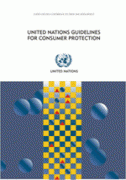 The UN Guidelines on Consumer Protection
The UN Guidelines on Consumer Protection
Most of the region’s consumer protection laws have been proposed and adopted since the United Nations General Assembly (UNGA) in 1985 approved by consensus the “Guidelines for Consumer Protection.” These Guidelines were amended/expanded in 1999 (English, Spanish, French) to incorporate principles on “sustainable consumption.” [A bit of UN trivia: which country’s UN delegation championed the original version of the Guidelines and ensured that they made it to UNGA endorsement? Answer: Venezuela.]
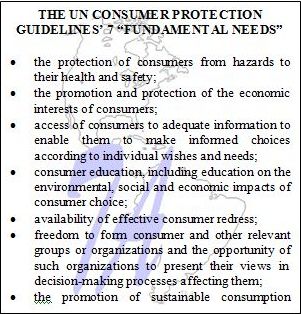 Due to the opposition of certain parties during the negotiations (take a guess which!), the Guidelines do not refer to “rights” so much as seven “legitimate needs” that consumer protection rules should address (see box). These were formulated in very terse and general terms so that each of the UN member states could embellish on them as they saw fit.
Due to the opposition of certain parties during the negotiations (take a guess which!), the Guidelines do not refer to “rights” so much as seven “legitimate needs” that consumer protection rules should address (see box). These were formulated in very terse and general terms so that each of the UN member states could embellish on them as they saw fit.
After the first version of the Guidelines were approved, the UN sponsored some regional consultations and workshops on consumer policy in LAC in which the Guidelines were promoted as a template for national laws. For its part, Consumers International (CI) — then known as the International Organization of Consumers Unions (IOCU) — and its LAC affiliates promoted the Guidelines as a minimum — a foundation on which to build, rather than a ceiling to limit the content and scope of national consumer laws.
Some of the post-1985 bills to create consumer protection laws in LAC explicitly cited the UN Guidelines. But even in LAC nations that do not openly acknowledge the Guidelines’ influence, officials will privately admit that the Guidelines and some of the follow-up regional education/ cooperation efforts did shape the drafting of their laws.
- Parlatino’s Model Law
 Whereas the UN Guidelines were the model/influence for many of first generation consumer protection measures across the region, the “model framework law” (Spanish. Portuguese) approved last year by the Latin American Parliament (“Parlatino“) may influence the next generation of legislative activity in the Spanish and Portuguese speaking nations — the reforms, amendments, enhancements and fine-tuning many national laws appear poised to undergo in the next few years.
Whereas the UN Guidelines were the model/influence for many of first generation consumer protection measures across the region, the “model framework law” (Spanish. Portuguese) approved last year by the Latin American Parliament (“Parlatino“) may influence the next generation of legislative activity in the Spanish and Portuguese speaking nations — the reforms, amendments, enhancements and fine-tuning many national laws appear poised to undergo in the next few years.
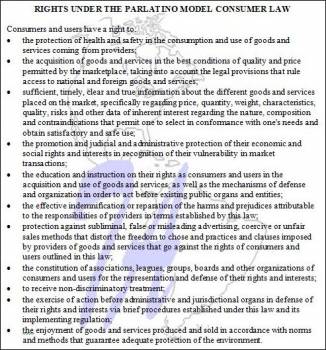 The São Paulo-based Parlatino is a several decades old* institution designed to promote cooperation and exchange of ideas among Latin American legislators. Its members include Brazil and all the Spanish-speaking nations of the region, plus Suriname, Aruba and the Netherlands Antilles. Parlatino operates via theme-based commissions, including one on consumer protection. These commissions try to develop a consensus on many of the topical issues of the day in their national legislatures, and often draft model laws the legislators can take home to use as guide in legislative proposals.
The São Paulo-based Parlatino is a several decades old* institution designed to promote cooperation and exchange of ideas among Latin American legislators. Its members include Brazil and all the Spanish-speaking nations of the region, plus Suriname, Aruba and the Netherlands Antilles. Parlatino operates via theme-based commissions, including one on consumer protection. These commissions try to develop a consensus on many of the topical issues of the day in their national legislatures, and often draft model laws the legislators can take home to use as guide in legislative proposals.
Parlatino’s User and Consumer Defense Commission first approved a model framework for national consumer codes as early as 1997. That model code was ghost-drafted by CI, based in part on the UN Guidelines and Brazil’s Consumer Code. The 1997 model was shopped around several national legislatures in the late 1990s, and pieces of it ended up in several bills proposed and later adopted.
The May 2006 model law, far more detailed and sweeping, is already making the rounds of national legislatures in LAC.
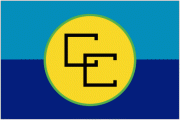 Caricom’s Consumer Protection Protocol
Caricom’s Consumer Protection Protocol
You may have noticed that the English-speaking Caribbean does not participate in Parlatino. For these nations, the greater influence is likely to be Part VI (Consumer Protection) of Protocol VIII of the Treaty Creating the Caribbean Community (Caricom). The Protocol was signed by 12 Caricom member states but only ratified by one (Guyana), but was then rolled into the revised Treaty of Chaguaramas creating the Caribbean Single Market and Economy (CSME). The revised Treaty and its Protocols finally came into effect in 2006 after several years of provisional application.
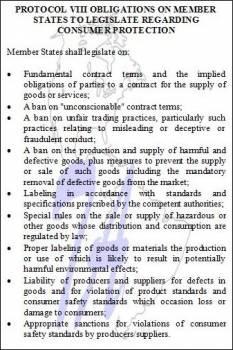 The Protocol not only outlines what items should be protected under “harmonized legislation” (implying that some work toward harmonization is likely) enacted by Community member states (see box — click to enlarge), but also calls on the Community Commission to promote consumer education, propose quality standards for consumer products, promote the elaboration and adoption of fair contract terms, but also to
The Protocol not only outlines what items should be protected under “harmonized legislation” (implying that some work toward harmonization is likely) enacted by Community member states (see box — click to enlarge), but also calls on the Community Commission to promote consumer education, propose quality standards for consumer products, promote the elaboration and adoption of fair contract terms, but also to
(b) take such measures as it considers necessary to ensure that Member States discourage and eliminate unfair trading practices, including misleading or deceptive conduct, false advertising, bait advertising, referral selling and pyramid selling;
(l) make recommendations to the COTED for the enactment of legislation by the Member States for the effective enforcement of the rights of consumers.
It was anticipation of such a lead role by Caricom in consumer affairs that led consumer groups in 2005 to form a special “Caribbean Consumer Council” to lobby Caricom on consumer issues.
 MERCOSUR Efforts to Create a Consumer Dimension
MERCOSUR Efforts to Create a Consumer Dimension
As I mentioned in the article on MERCOSUR’s recent measure on deceptive advertising, despite an early resolve to create a comprehensive regulation on consumer protection, the common market instead ended out tackling consumer issues piecemeal over the years, with measures on advertising and contractual guarantees. It could also be argued, however, that protecting the consumer was frequently invoked in the MERCOSUR work programs on health and safety aspects of cosmetics, food, pharmaceuticals, personal care products and cleaning products (more on this work in a future Temas Blog entry).
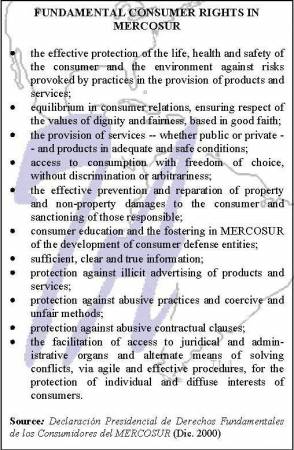 In 2000 MERCOSUR decided to formally declare consumer protection a MERCOSUR priority, but did so through the curious vehicle of a “Presidential Declaration on Fundamental Rights of MERCOSUR Consumers” instead of a Protocol, Decision or Resolution. The Declaration listed 11 rights (click on box at right to enlarge) — although it can be argued that #6 can/should be divided into two, one on consumer education, the other on consumer entities — that should guide MERCOSUR work and national law of of MERCOSUR member states.
In 2000 MERCOSUR decided to formally declare consumer protection a MERCOSUR priority, but did so through the curious vehicle of a “Presidential Declaration on Fundamental Rights of MERCOSUR Consumers” instead of a Protocol, Decision or Resolution. The Declaration listed 11 rights (click on box at right to enlarge) — although it can be argued that #6 can/should be divided into two, one on consumer education, the other on consumer entities — that should guide MERCOSUR work and national law of of MERCOSUR member states.
Has this resulted in a flood of new MERCOSUR initiatives on consumer protection or a fundamental rewrite of member state consumer laws to reflect the Declaration? Not yet, even though a work group on consumer protection (“Technical Committee No. 7”) was created and it has worked on such diverse issues as e-commerce, abusive contract clauses and timeshares. But as I noted in the prior post on advertising, recently MERCOSUR has increased its work on consumer-related issues and there are legislative proposals in some member states to revise existing consumer law, so stay tuned.
- Other Regional Actors?
Although they might claim consumer protection as one of their aims, Andean Community’s (CAN) does work on harmonizing member state rules on cosmetics and the Central American Integration System’s (SICA) does work on food and pharmaceuticals that are really more about reducing technical barriers to trade. Neither body appears ready at the moment to dive deeper into consumer protection issues.
Stay tuned for Part II-B, the guide to national and subnational legislation.
— Keith R
* Parlatino was originally formed as early as 1964 in Lima, but did get fully institutionalized and develop a significant profile until a 1987 treaty formalized its role and status.
Tags: abusive contract clauses, after-sales service, alimentos, Andean Community, Caribbean Consumer Council, CARICOM, cleaning products, Comunidad Andina, consumer awareness, consumer law, Consumer Protection, Consumers International, consumo sostenible, contractual guarantees, cosméticos, cosmetics, CSME, deceptive conduct, defensa del consumidor, defesa do consumidor, detergents, doorstep sales, e-commerce, fair contract terms, false advertising, food, IOCU, labeling, medicamentos, medicines, MERCOSUL, MERCOSUR, misleading advertising, model law, NOM, OECS, offers, ombudsman, Parlatino, Pernambuco, personal care products, pharmaceuticals, portaria, productos de limpieza, produtos de limpeza, promotions, protection des consommateurs, Protocol VIII, pyramid selling, recalls, referral selling, Sanitary Code, SICA, sustainable consumption, telemarketing, timeshares, Treaty of Chaguaramas, UN Consumer Protection Guidelines, unfair trading practives, UNGA, written sales contracts



April 14th, 2007 at 0:36
Latin America Consumer Protection…
Great report on consumer issues in Latin America and the Caribbean…….
January 13th, 2008 at 19:07
Well done on a very informative site. You may wish to add the internationally recognised 8 consumer rights as developed by JFK and the Consumers International:
How are Consumer Rights defined?
1. The right to satisfaction of basic needs – To have access to basic, essential goods and services: adequate food, clothing, shelter, health care, education, public utilities, water and sanitation.
2. The right to safety – To be protected against products, production processes and services which are hazardous to health or life.
3. The right to be informed – To be given the facts needed to make an informed choice, and to be protected against dishonest or misleading advertising and labelling.
4. The right to choose – To be able to select from a range of products and services, offered at competitive prices with an assurance of satisfactory quality.
5. The right to be heard – To have consumer interests represented in the making and execution of government policy, and in the development of products and services.
6. The right to redress – To receive a fair settlement of just claims, including compensation for misrepresentation, shoddy goods or unsatisfactory services.
7. The right to consumer education – To acquire knowledge and skills needed to make informed, confident choices about goods and services, while being aware of basic consumer rights and responsibilities and how to act on them.
8. The right to a healthy environment -To live and work in an environment which is non-threatening to the well-being of present and future generations.
All the best
John Wood
January 13th, 2008 at 23:24
Thanks for the kind words, John, and welcome to The Temas Blog. I actually mentioned Kennedy’s speech (complete with a link to a text of said speech) and CI’s championing of it in the Introduction to this series, so I did not feel the need to repeat it here, but maybe should have.
Best regards,
Keith
January 14th, 2008 at 0:55
Thanks for the response Keith. I was not criticising, but rather pointing out that in terms of chronology JFK’s four rights led to Consumer Internationsl’s eight rights and it was these that formed the basis of the UN Guidelines for Consumer Protection. I was formerly head of the Australian Government’s consumer policy agency and involved in the development of the UN Guidelines and their propagation in the Asia-Pacific Region.
January 14th, 2008 at 10:59
I didn’t think you were criticizing, John, just thought perhaps you’d missed the intro. You’re right, I perhaps should have clarified the chronology/evolution in this entry. I’m never sure how much and which detail on policy issues to get into on a blog entry, for fear of losing readers not as fascinated in the issue as I am.
As someone who worked on the development of the Guidelines and headed a consumer agency, a double welcome to the Temas Blog! 🙂 I hope this is not your last visit, and please feel free to input on consumer issues here — or any other, for that matter! I like feedback, discussion — it’s the only way to improve the blog, which is something I’m always striving for.